Most inflatable tents have sewn-in groundsheet. This has now become some kind of ‘remark of quality’, so cheaper models tend to have sewn-in groundsheets too just to make the impression that they play in a higher league.
If you are looking for an air tent with sewn-in groundsheet to make sure that you are protected from the elements – especially water leaking in – you are at the best place to find out which air tents are the best just for that.
I am also telling you;
- Why you might not want an air tent (or any tent for that matter) with a sewn-in groundsheet – yes, there are some disadvantages, believe it or not;
- Which models you should avoid right away if you want a fully sealed air tent; and
- Which air tent I recommend if you are looking for the best air tent with sewn-in groundsheet
Inflatable Tents Sewn-in Groundsheet v Linked Groundsheet
| Brand | Model | Groundsheet |
|---|---|---|
| Airgo | Air Genus 400 | Linked |
| Airgo | Air Genus 800 | Linked |
| Berghaus | Air 4 | Sewn-in |
| Berghaus | Air 4 XL | Sewn-in |
| Berghaus | Air 6 | Sewn-in |
| Berghaus | Air 6 XL | Sewn-in |
| Berghaus | Air 6 XL Polycotton | Sewn-in |
| Coleman | Fastpitch Air Valdes 4 | Sewn-in |
| Coleman | Fastpitch Air Valdes 6 | Sewn-in |
| Coleman | Weathermaster 4XL Air | Sewn-in |
| Coleman | Weathermaster 8XL Air | Sewn-in |
| Eurohike | Air 400 | Sewn-in |
| Eurohike | Air 600 | Sewn-in |
| Kampa | Brean 4 | Sewn-in |
| Kampa | Croyde 6 | Sewn-in |
| Kampa | Dometic Brean 3 | Sewn-in |
| Kampa | Dometic Wittering 6 | Sewn-in |
| Kampa | Hayling 4 | Sewn-in |
| Kampa | Kielder 5 | Sewn-in |
| Outdoor Revolution | Airedale 6 | Sewn-in |
| Outdoor Revolution | Airedale 7.0SE | Sewn-in |
| Outdoor Revolution | Airedale 8.0 | Sewn-in |
| Outdoor Revolution | Cruiz 4.0 | Sewn-in |
| Outdoor Revolution | Cruiz 6.0TXL | Sewn-in |
| Outdoor Revolution | Edale 7 | Sewn-in |
| Outdoor Revolution | Kalahari PC 7.0 | Sewn-in |
| Outwell | Hartsdale 6PA | Sewn-in |
| Outwell | Lindale 3PA | Sewn-in |
| Outwell | Lindale 5PA | Sewn-in |
| Outwell | Reddick 4A | Sewn-in |
| Outwell | Roseville 6SA | Sewn-in |
| Outwell | Woodburg 7A | Sewn-in |
| Pavillo | Sierra Ridge Air (Pro) 4 | Linked |
| Pavillo | Sierra Ridge Air Pro X6 | Sewn-in |
| Portland Outdoor | Alfa 5 | Sewn-in |
| Quechua | Air Seconds 4.1 | Linked |
| Quechua | Air Seconds 4.1 Fresh & Black | Linked |
| Quechua | Air Seconds 6.3 Fresh & Black | Linked |
| Sprayway | Valley M | Sewn-in |
| Sprayway | Valley XL | Sewn-in |
| Vango | Alton 400 Air | Sewn-in |
| Vango | Celino Air 400 | Sewn-in |
| Vango | Icarus Air 600 | Sewn-in |
| Vango | Icarus Air Vista 600 | Sewn-in |
| Vango | Lomond 450 Air | Sewn-in |
| Vango | Longleat II 800XL | Sewn-in |
| Vango | Odyssey Air 600 | Linked |
| Vango | Odyssey Air 600 Deluxe | Sewn-in |
| Vango | Portland 400 | Linked |
| Vango | Rivendale 500XL | Sewn-in |
| Vango | Valencia II 650XL | Sewn-in |
| Vango | Vango Tahiti II 850XL | Sewn-in |
| Vango | Ventanas 650XL | Sewn-in |
| Zempire | Any | Sewn-in |
If you haven’t already, you should have a look at the previous episodes:
Part 1: Best air Tents UK / US / AUS
Part 2: Best air tents / inflatable tents with blackout bedroom
Part 3 (this post): Best air tents with sewn-in groundsheet
Part 4: Best air tents in wind
Sewn-in vs Linked Groundsheet
There are not too many disadvantages of a sewn-in groundsheet, but there are some.
Firstly – especially cheaper models – won’t have a flat entrance if the groundsheet is fully sewn-in. This may become an issue if you or anyone in the group or the family have a disability, as the threshold can be quite high sometimes.
Sewn-in groundsheets seal better, that’s great because water does not come in. But it also means that it does not go out either. As most tents have a polyester – full waterproof – flysheet too, in rainy weather or even in a colder morning, it can become quite humid inside the tent.
Even if you leave the flaps open the humidity in the air can turn into condensation on the inside of the flysheet if the temperature drops in the morning. Tents with a sewn-in groundsheet and lower quality flysheet will more likely suffer from this effect.
If the fabric of the inner tent touches the inside of the flysheet, it will become damp very quickly. It can be quite surprising – and not in a good way – to wake up in the morning and find that the wall of the inner tent is wet, even though it has not even rained.
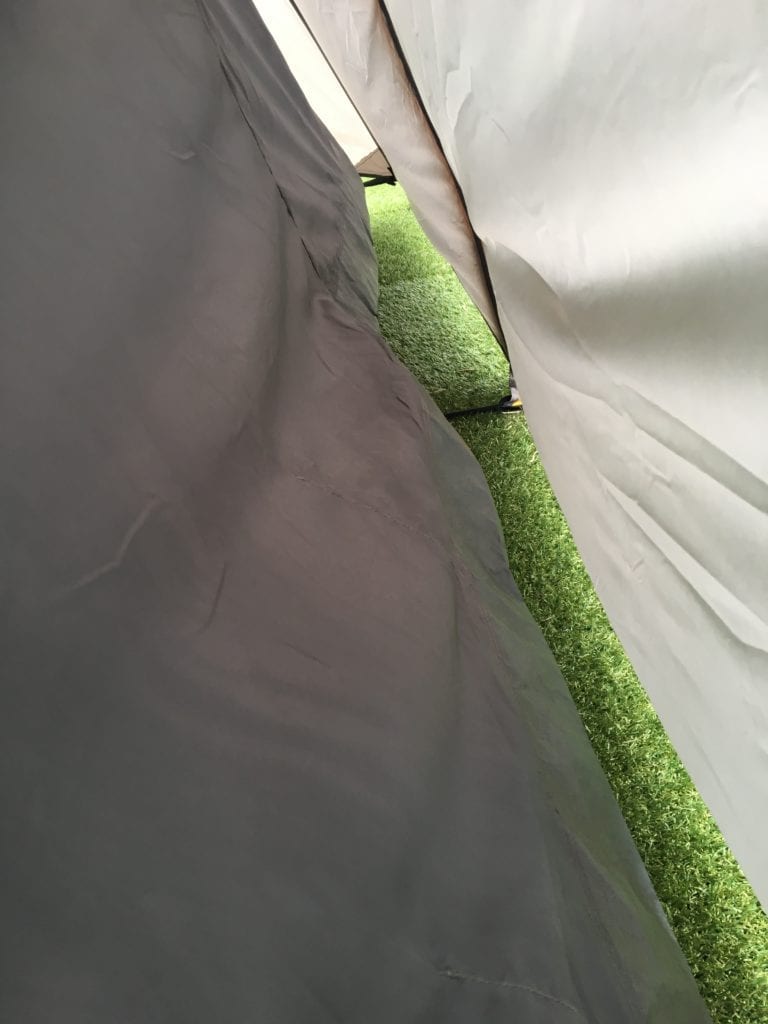
Airgo Air Genus 400 / 800. No groundsheet under the bedrooms, but it helps reducing the condensation on the flysheet
Tents with a linked-in groundsheet have better ventilation throughout, and the temperature inside will be much closer to the temperature outside: it is less likely to experience that condensation on the backside of the flysheet.
That’s why it can be tricky buying a cheap air tent with a thin flysheet AND a sewn-in groundsheet. The thin flysheet has very little effect on keeping the warmth inside the tent, and the inner side will become cold enough for the humidity in the air inside the tent to turn into water droplets. Those will very likely run down on the inside of the flysheet creating a nice little puddle in the middle of the tent, or fall onto the inner tent which is not waterproof at all.
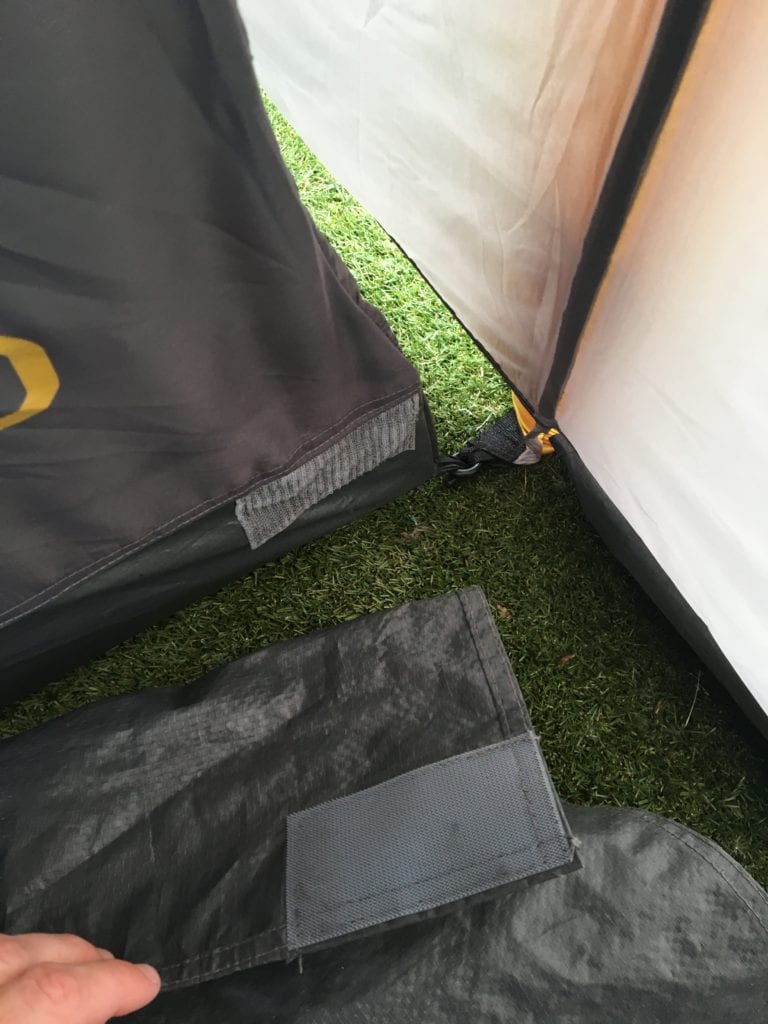
Benefits of the ‘Linked’ groundsheet vs a sewn-in groundsheet: you can just roll it away whenever you’d like to.
Lastly, depending what you do during the day and how dirty your gear is when you return, a linked-in groundsheet can be rolled up as necessary. You don’t bring the muck onto the groundsheet, so it may be easier to keep it relatively clean.
On the other hand, if you have a tent with a linked-in groundsheet, prepare yourself that every insect you can imagine will find it’s way inside the tent. You can buy a bunch of insect repellent lamps though, I used a pair of these and they worked pretty well, but it’s a tough call…
Air tents that don’t have a sewn-in groundsheet
Quite a few manufacturers – especially on the lower end of the market – prefer keeping quiet about the groundsheet if its now sewn in. So if you can’t find anything on the groundsheet in a product description, it will most likely be a linked groundsheet.
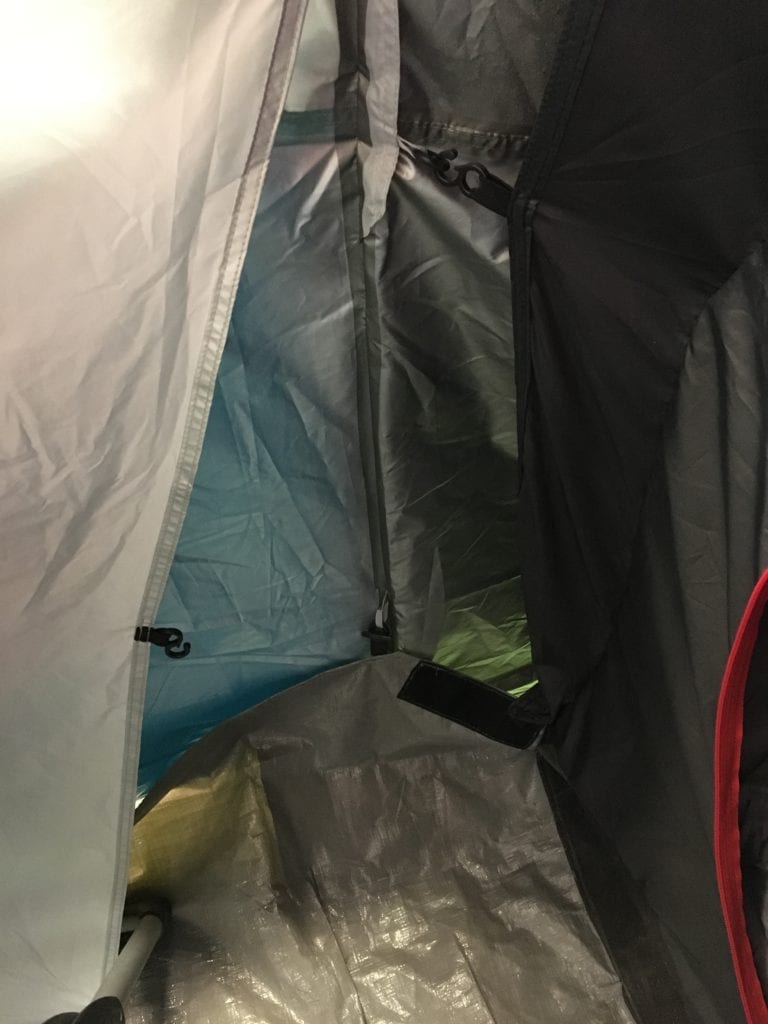
Quechua Air Seconds – Slightly more sophisticated than the Air Genus, but the groundsheet is not sewn in
If you have browsed through the table at the top of this page (or filtered to ‘Linked’), then you may already have an idea about which type of air tents don’t have a sewn-in groundsheet.
Not a definitive list, but you should probably avoid the following models:
- Airgo Air Genus 400
- Airgo Air Genus 800
- Eurohike Genus 400
- Eurohike Genus 800
- Pavillo Sierra Ridge Air 4
- Quechua Air Seconds – All models
- Vango Odyssey Air 600 and Air 600SC
- Vango Portland 400
Inflatable tent with the strongest groundsheet
When it comes to finding the air tent with the most durable groundsheet, you must at look at two things: the fabric itself, and the coating.
The coating is important, because as you stand on top of it, the water pressure ‘on the other side’ of the groundsheet can increase dramatically. They say you need at least 3,000mm HH water resistance on the groundsheet (other sources recommend at least 5,000mm HH).
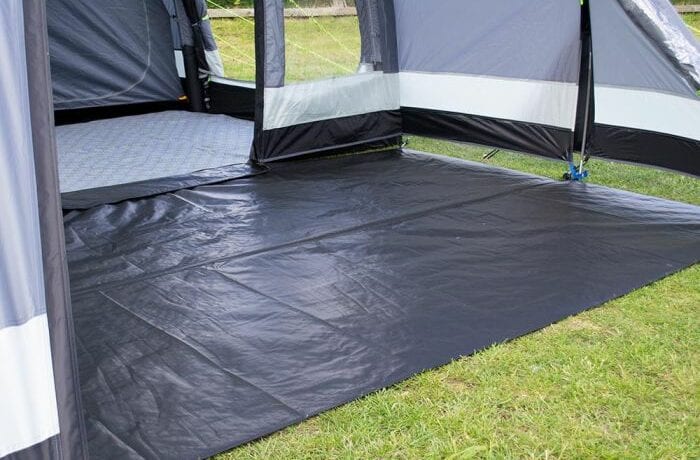
Kampa Kielder 4/5 loose ground sheet under the porch that can be rolled up – fully sewn-in with drop-flat threshold under the living room
The fabric itself is important too, cause the coating won’t keep the weaves together and won’t make the groundsheet miraculously resistant to ripping / tearing.
So you need something that’s thick, but not too heavy; durable but not rigid. Standard tarpaulin is around 120 gsm. Tarps above 250gsm are considered heavy-duty – these are the ones that you can see on market stalls for example. What you must know, that they are not water-resistant naturally, they are treated with a coating too.
You can buy additional footprint for most air tents, and having a soft carpet on top of it can help reducing the counter-pressure from the other side (as well as adding some extra comfort)
So the best air tent with overall ‘groundsheet properties’ – in my opinion anyways – is the
Kampa Kielder 5
Why?
- It has a fully sewn-in groundsheet that is 130 g/m² (gsm) thick, and has 10,000 mm HH water-resistance. (The Kampa Kielder 4 has identical features by the way)
- There is an option to buy an additional footprint
- You have the option to buy an additional soft fleece matching carpet
- You can have all three in a bundle
With other air tents, you will have one or two of the above bullet-points missing. There won’t be a carpet. There’s a footprint but it is out of stock since late 2018. There’s no info on the groundsheet HH rating. Or if there is, you don’t know how thick the fabric is and the whole tent is less than 15 kgs, which is not very promising…
The Kampa Kielder 5 has the best all-round properties.
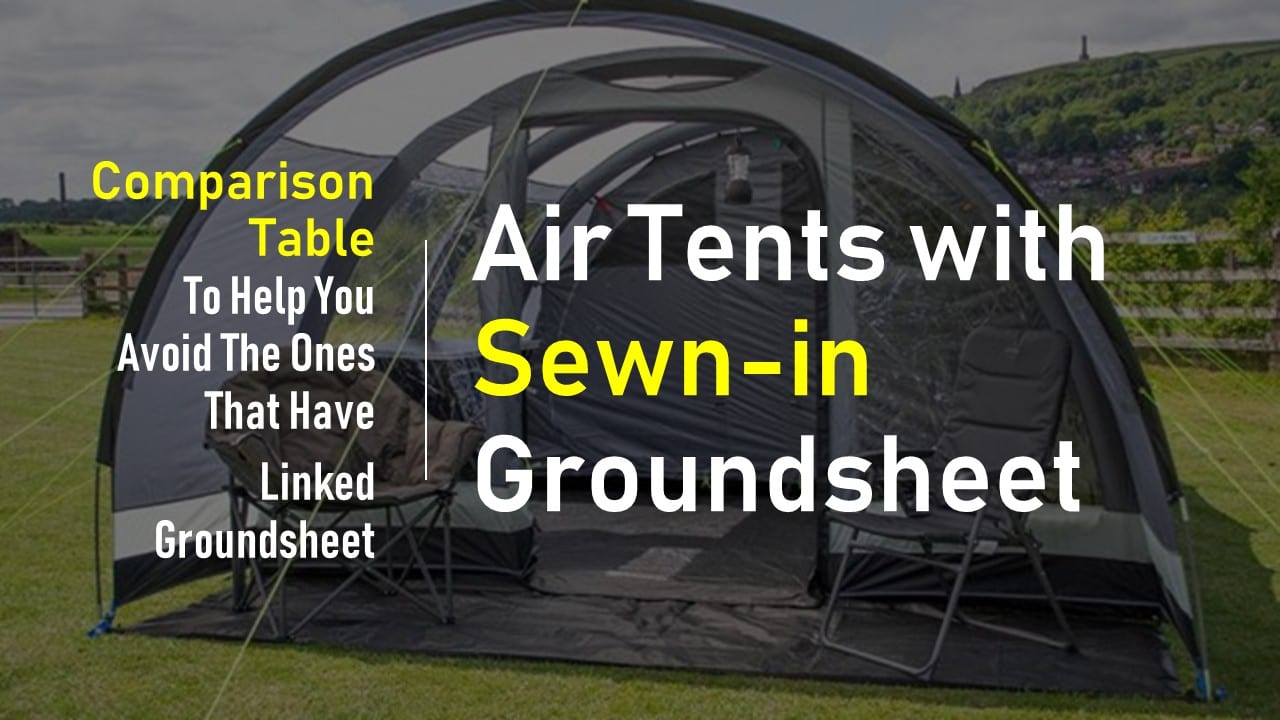
Are these https://www.dometic.com/en-gb/uk/products/climate/camping-tents/inflatable-tents/kampa-dometic-hayling-4-classic-air-_-242783#specifications comparable to the 5?
Hi,
Yes and no 🙂 the Hayling CLASSIC, although looks very similar to the Kielder 5, is a polycotton tent. Also, there are two equal size bedrooms, 150 cms wide each. The CLASSIC range is considerably more expensive. So they are comparable, but the Hayling 4 classic plays in an entirely different league.
I wondered if you would ever consider adding a column to your table about the weight of the tents. Possibly even the pack size. I recently bought a Berghaus 6XL and is it tremendously heavy and bulky. I think potential purchasers could do with the heads up that if they have a small or medium sized car, they well be needing to get a roof box as the tent will occupt their boot. I don;t mind doing this as it is a fix that works, but the weight is on the brink of being a deal breaker. One person could not safely lift that into a car and i think this needs acknowledged somewhere, somehow.